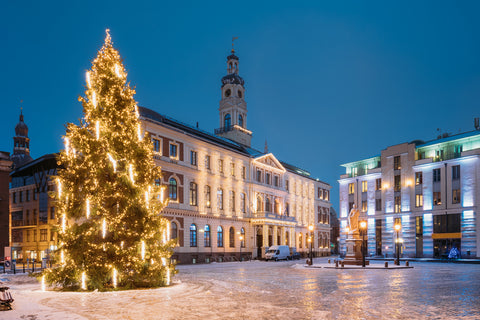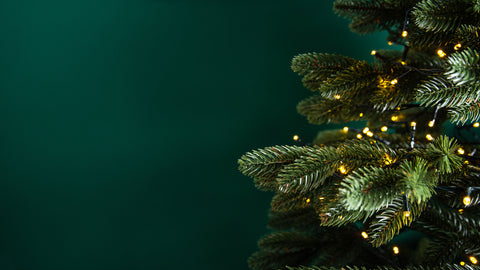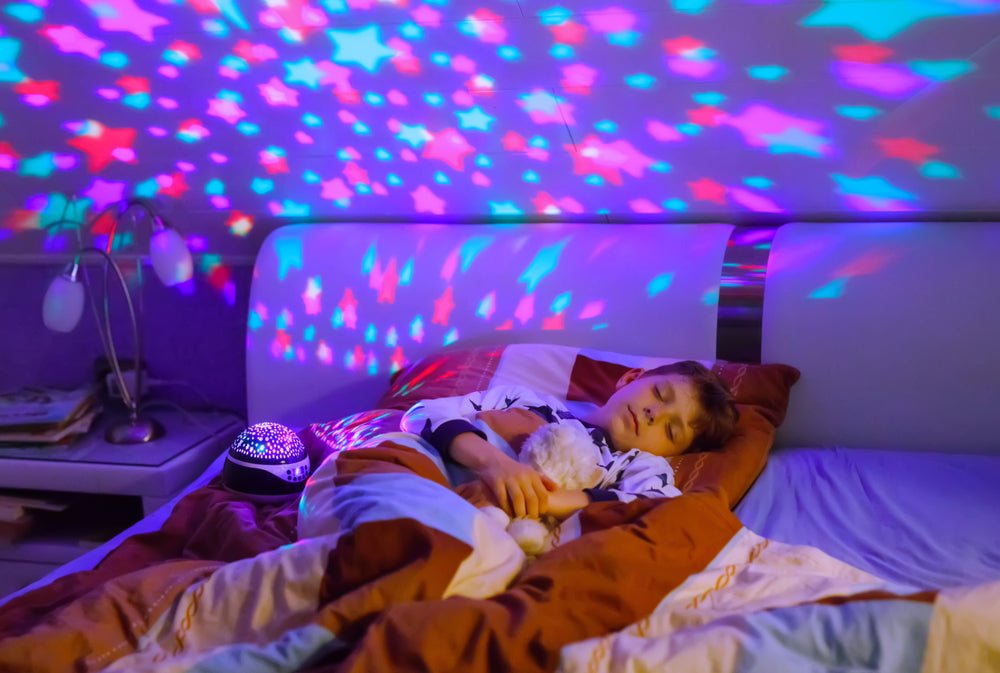The most popular Christmas lights in the UK are typically LED string lights, which come in a variety of colors and styles and are energy-efficient compared to traditional incandescent lights. Other popular options include battery-operated lights, icicle lights, and outdoor projection lights.
One of the most iconic Christmas lights displays in the UK is the Oxford Street Christmas Lights in London. This display features thousands of LED lights strung across the street and is usually switched on in mid-November.
Another popular display is the Christmas Lights Trail at Kew Gardens in London. This features illuminated trees, light sculptures, and a laser garden.
In Manchester, the Christmas Markets feature a stunning light display throughout the city center, including a giant illuminated Santa Claus.
In Birmingham, the city center is transformed into a winter wonderland with a large Christmas Lights switch-on event featuring a spectacular display of lights and fireworks.
Finally, Edinburgh's Christmas celebrations feature a Light Night event where the city is transformed into a magical winter wonderland with a variety of light displays, including a light trail in the Royal Botanic Garden.
What do Christmas Lights Do?
Christmas lights, also known as fairy lights, are decorative lights commonly used to adorn Christmas trees and homes during the holiday season. They come in a variety of shapes, sizes, and colors, and are typically strung together in a series, creating a festive and dazzling display.
In addition to their decorative purposes, Christmas lights also have symbolic significance. They are often used to represent the star that led the three wise men to Bethlehem in the biblical story of Jesus' birth. They can also represent hope, joy, and the warmth of the holiday season.
In recent years, Christmas lights have become increasingly popular as outdoor decorations, with many people using them to create elaborate displays on their homes and in their yards. This trend has even led to the development of Christmas light shows, where entire neighborhoods coordinate their displays to create a synchronized light and music show for visitors to enjoy.
What is The History of Christmas Lights?
The history of Christmas lights can be traced back to the 17th century when candles were used to decorate Christmas trees. In the early days, candles were affixed to the branches of the tree using melted wax or pins, and they provided a warm and cozy glow.
However, this practice was also dangerous as the candles posed a fire hazard, and many homes were destroyed by Christmas tree fires. As a result, in the late 19th century, electric lights were developed as a safer alternative to candles.
The first electric Christmas lights were invented by Thomas Edison in 1880, but they were too expensive for most people to afford. It wasn't until the early 20th century that electric Christmas lights became widely available and popular.
In 1917, the first commercially available Christmas lights were introduced by a company called NOMA, which used a series circuit of small bulbs wired together in parallel. This made the lights more reliable and easier to replace if one bulb burned out.
Over time, Christmas lights have evolved and become more complex, with the introduction of new technologies such as LED lights, which are energy-efficient and last longer than traditional incandescent bulbs. Today, Christmas lights are an essential part of holiday decorations, and people all over the world use them to create festive and beautiful displays.
Where Does Christmas Lights Get Its Name?
The term "Christmas lights" refers to the decorative lights that are used to adorn homes, Christmas trees, and other holiday decorations during the Christmas season. The name "Christmas lights" is derived from the fact that they are traditionally used to celebrate the Christian holiday of Christmas, which commemorates the birth of Jesus Christ.
Christmas lights are also sometimes referred to as "fairy lights," which is a term that originated in the United Kingdom. The name "fairy lights" comes from the idea that the lights resemble the twinkling of fairy dust, adding a magical and enchanting quality to Christmas decorations.
In other parts of the world, Christmas lights may have different names. For example, in some Spanish-speaking countries, they are called "luces de Navidad," which translates to "Christmas lights," while in Japan, they are known as "illuminations," reflecting the country's love of bright and colorful light displays during the holiday season.
What Are Popular Christmas Lights?
The most popular type of Christmas lights varies depending on personal preference and regional traditions, but there are a few types that are commonly used and widely available.
One of the most popular types of Christmas lights is the traditional incandescent bulb, which has been a classic choice for many years. These lights emit a warm, cozy glow and come in a range of colors and sizes.
Another popular option is LED lights, which are becoming increasingly popular due to their energy efficiency and durability. LED lights use less electricity than traditional bulbs and can last for many years, making them a cost-effective choice in the long run.
In recent years, there has also been a trend towards unique and creative Christmas lights, such as projection lights that can create animated displays on the side of a house or building, and smart lights that can be controlled with a smartphone app and programmed to change colors and patterns.
Ultimately, the most popular Christmas lights are those that bring joy and holiday cheer to the people who use them.
How Do Christmas Lights Work?
Christmas lights, also known as fairy lights, work by using electricity to illuminate small bulbs. When the lights are plugged into an electrical outlet, the electricity flows through a wire to a small filament inside each bulb. This filament heats up, causing the bulb to emit light.
In traditional incandescent Christmas lights, the filament is made of a thin wire that is heated by the electric current until it glows. The bulbs are wired together in a series circuit, which means that if one bulb burns out, the whole strand may stop working.
In more modern LED Christmas lights, the bulbs use a different type of technology. Instead of a heated filament, LEDs use a semiconductor to emit light. This technology is much more energy-efficient than traditional incandescent bulbs, which means that LED lights use less electricity and last longer.
Regardless of the type of bulbs used, Christmas lights are typically strung together in a series, with each bulb connected to the next by a wire. The strands may be plugged into an electrical outlet using an extension cord or a power strip, and may be controlled by an on/off switch or a timer.
What Do Christmas Lights Represent?
Christmas lights can represent different things depending on cultural, religious, and personal contexts. However, there are a few common themes and meanings associated with Christmas lights that many people share.
One of the main symbolic meanings of Christmas lights is the celebration of the holiday season itself. The lights help to create a festive and joyful atmosphere, and they are often used to decorate homes, streets, and public spaces to mark the occasion of Christmas.
Another symbolic meaning of Christmas lights is the idea of hope and warmth during the darkest time of the year. In many cultures, the winter solstice is seen as a time of renewal and rebirth, and the lights may represent the idea that even in the coldest and darkest of times, there is always a spark of light and hope to be found.
For Christians, Christmas lights may also represent the birth of Jesus Christ, who is often referred to as the "light of the world." The lights may symbolize the divine light that came into the world with the birth of Christ, and the hope and salvation that he brought to humanity.
How Long Do LED Christmas Lights Last?
LED Christmas lights are known for their durability and long lifespan, which is one of the reasons why they have become increasingly popular in recent years. On average, LED Christmas lights can last up to 50,000 hours or more, which is significantly longer than traditional incandescent bulbs.
The lifespan of LED Christmas lights can vary depending on several factors, such as the quality of the lights, how often they are used, and whether they are exposed to harsh weather conditions. However, with proper care and storage, LED Christmas lights can last for many years.
LED lights also use less energy than traditional bulbs, which means that they are more cost-effective in the long run. They produce less heat and are less likely to overheat or cause a fire, making them a safer option for indoor and outdoor use.
Overall, the long lifespan and energy efficiency of LED Christmas lights make them a popular choice for holiday decorating, as they can be used for many years without needing to be replaced.
What Are The Colors of Christmas Lights?
The colors of Christmas lights can vary depending on personal preference and cultural traditions, but there are a few colors that are commonly associated with the holiday season.
The most popular colors for Christmas lights are red, green, and white. Red is often associated with the colors of Santa Claus's suit and represents warmth, joy, and love. Green is associated with the color of Christmas trees and represents nature, renewal, and growth. White is often used to create a classic, elegant look and can represent purity, peace, and light.
Other colors that are commonly used for Christmas lights include blue, which represents the winter season and can create a cool, serene atmosphere. Gold and silver are also popular choices for a more glamorous and sophisticated look, while pink and purple may be used for a more whimsical or playful feel.
In recent years, there has also been a trend towards using multicolored Christmas lights, which can create a festive and colorful display. These lights may feature a combination of red, green, blue, yellow, and other colors, and can be used to create unique and creative designs.
Overall, the colors of Christmas lights are a matter of personal preference and can be used to express different themes and moods during the holiday season.
What Do Christmas Light Colors Mean?
In general, the colors of Christmas lights do not have specific meanings in a traditional or religious sense. However, they can still carry symbolic and emotional associations that may vary depending on cultural and personal contexts.
Here are some common associations and emotions that are often associated with the colors of Christmas lights:
- Red: Warmth, joy, love, and passion. Red is a popular color for Christmas lights as it is associated with Santa Claus's suit and can create a festive and lively atmosphere.
- Green: Nature, renewal, growth, and stability. Green is often associated with Christmas trees and can represent the hope and promise of the holiday season.
- White: Purity, peace, and light. White is a classic color for Christmas lights and can create an elegant and sophisticated look.
- Blue: Serenity, calmness, and winter. Blue is a popular color for winter-themed decorations and can create a cool and tranquil atmosphere.
- Gold and silver: Luxury, glamour, and prosperity. These colors can create a more sophisticated and upscale look and are often used for more formal or upscale decorations.
- Multicolored: Fun, excitement, and creativity. Multicolored lights can create a festive and playful atmosphere and are popular for creating unique and colorful displays.
What Are The Types of Christmas Lights?
There are various types of Christmas lights available, each with its own unique style and features. Here are some of the most common types of Christmas lights:
Incandescent lights: These are traditional filament-based lights that have been used for many years. They are available in various shapes and sizes, including dome, bulb (such as C5, C7, C9, G40, and G50), and novelty lights.
LED lights: LED lights are becoming increasingly popular due to their energy efficiency and long lifespan. They are available in a range of colors and styles, including mini lights, net lights, rope lights, and projector lights.
Orb lights: These are globe-shaped lights that can be used to create a warm and cozy atmosphere. They are available in various sizes and colors.
Icicle lights: These lights have a unique design that resembles dripping icicles, and can be used to create a sparkling and festive display. They are available in various lengths and colors.
Solar Christmas lights: These lights use solar panels to generate power, making them a more eco-friendly option. They are available in various styles and colors, including mini lights, rope lights, and decorative figures.
Overall, there are many different types of Christmas lights available, each with its own unique features and benefits. The type of lights you choose will depend on your personal preferences and the look you want to create.
Are Christmas Lights Used Outdoor?
Yes, Christmas lights are commonly used both indoors and outdoors to decorate homes, gardens, trees, and other outdoor spaces during the holiday season.
Outdoor Christmas lights are typically designed to withstand harsh weather conditions, such as rain, snow, and wind, and may be rated for outdoor use. These lights may have extra insulation, thicker cords, and weather-resistant connections to prevent them from becoming damaged by exposure to the elements.
When using Christmas lights outdoors, it's important to follow some safety guidelines to prevent accidents and damage. For example, you should only use lights that are rated for outdoor use, and avoid overloading electrical circuits or using damaged or frayed wires. It's also important to use a sturdy ladder and secure the lights properly to prevent them from falling or causing a hazard.


